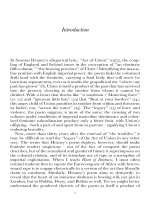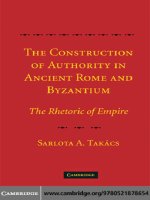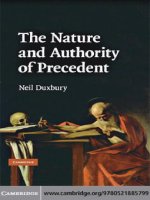cambridge university press bankruptcy of empire mexican silver and the wars between spain britain and france 1760 1810 nov 2007 kho tài liệu bách khoa
Bạn đang xem bản rút gọn của tài liệu. Xem và tải ngay bản đầy đủ của tài liệu tại đây (1.92 MB, 338 trang )
P1: JZP
9780521879644pre
CUNY1040/Marichal
0 521 87964 7
August 23, 2007
This page intentionally left blank
ii
14:18
P1: JZP
9780521879644pre
CUNY1040/Marichal
0 521 87964 7
August 23, 2007
14:18
Bankruptcy of Empire
This book incorporates recent, rich literature on the history of the fiscal organization
and financial dynamics of the Spanish empire within the broader historical debates on
rival European imperial states in the eighteenth and early nineteenth centuries. The
focus is on colonial Mexico because it served as a fiscal and financial submetropolis
that ensured the capacity of the imperial state to defend itself in a time of successive
international conflicts.
Whereas the monarchy of Charles III (1759–1788) was able to successfully meet
the challenges of reinforcement of empire, the finances of the Spanish state began
to sink under Charles IV (1789–1808). This collapse was caused by the enormous
expense of waging successive wars in the Americas and Europe. In each war, colonial
Mexico was the most important source of resources for the Crown, but these demands
gradually outstripped the tax base of the viceroyalty despite the extraordinary silver
boom of the late eighteenth century. The bankruptcy of the Spanish monarchy and
its empire was the inevitable consequence.
Carlos Marichal was born in Baltimore, Maryland, and has dual nationality of both
the United States and Mexico. He earned his B.A. and Ph.D. from Harvard and has
taught history at the university level in Mexico since 1979. Since 1989, he has been
a professor of history at El Colegio de Mexico, the leading social science university
institute in Mexico. He is the founder and former president of the Mexican Association
of Economic History and has served on the executive committee of the International
Economic History Association since 2003. He is the author of A Century of Debt Crises
in Latin America, 1820–1930 (1989), and is the editor or coeditor of fifteen books in
Spanish and English, published over the last twenty years, the majority on the fiscal
and financial history of Mexico, as well as numerous texts on the economic history of
Latin America.
i
P1: JZP
9780521879644pre
CUNY1040/Marichal
0 521 87964 7
August 23, 2007
ii
14:18
P1: JZP
9780521879644pre
CUNY1040/Marichal
0 521 87964 7
August 23, 2007
14:18
cambridge latin american studies
General Editor
Herbert S. Klein
Gouverneur Morris Emeritus Professor of History, Columbia University
Director of the Center of Latin American Studies, Professor of History, and
Hoover Senior Fellow, Stanford University
91
Bankruptcy of Empire
Other Books in the Series
1. Ideas and Politics of Chilean Independence, 1808–1833, Simon Collier
2. Church Wealth in Mexico: A Study of the “Juzgado de Capellanias” in the
Archbishopric of Mexico 1800–1856, Michael P. Costeloe
3. The Mexican Revolution, 1910–1914: The Diplomacy of Anglo-American
Conflict, P. A. R. Calvert
4. Britain and the Onset of Modernization in Brazil, 1850–1914, Richard
Graham
5. Parties and Political Change in Bolivia, 1880–1952, Herbert S. Klein
6. The Abolition of the Brazilian Slave Trade: Britain, Brazil and the Slave
Trade Question, 1807–1869, Leslie Bethell
7. Regional Economic Development: The River Basin Approach in Mexico, David
Barkin and Timothy King
8. Economic Development of Latin America: Historical Background and Contemporary Problems, Celso Furtado and Suzette Macedo
9. An Economic History of Colombia, 1845–1930, W. P. McGreevey
10. Miners and Merchants in Bourbon Mexico, 1763–1810, D. A. Brading
11. Alienation of Church Wealth in Mexico: Social and Economic Aspects of the
Liberal Revolution, 1856–1875, Jan Bazant
12. Politics and Trade in Southern Mexico, 1750–1821, Brian R. Hamnett
13. Bolivia: Land, Location and Politics since 1825, J. Valerie Fifer, Malcolm
Deas, Clifford Smith, and John Street
14. A Guide to the Historical Geography of New Spain, Peter Gerhard
15. Silver Mining and Society in Colonial Mexico: Zacatecas, 1546–1700,
P. J. Bakewell
(Continued after index)
iii
P1: JZP
9780521879644pre
CUNY1040/Marichal
0 521 87964 7
August 23, 2007
iv
14:18
P1: JZP
9780521879644pre
CUNY1040/Marichal
0 521 87964 7
August 23, 2007
14:18
Bankruptcy of Empire
Mexican Silver and the Wars Between Spain, Britain, and France,
1760–1810
CARLOS MARICHAL
El Colegio de Mexico
v
CAMBRIDGE UNIVERSITY PRESS
Cambridge, New York, Melbourne, Madrid, Cape Town, Singapore, São Paulo
Cambridge University Press
The Edinburgh Building, Cambridge CB2 8RU, UK
Published in the United States of America by Cambridge University Press, New York
www.cambridge.org
Information on this title: www.cambridge.org/9780521879644
© Carlos Marichal 2007
This publication is in copyright. Subject to statutory exception and to the
provision of relevant collective licensing agreements, no reproduction of any part
may take place without the written permission of Cambridge University Press.
First published in print format 2008
ISBN-13
978-0-511-50808-0
eBook (NetLibrary)
ISBN-13
978-0-521-87964-4
hardback
Cambridge University Press has no responsibility for the persistence or accuracy
of urls for external or third-party internet websites referred to in this publication,
and does not guarantee that any content on such websites is, or will remain,
accurate or appropriate.
P1: JZP
9780521879644pre
CUNY1040/Marichal
0 521 87964 7
August 23, 2007
To Soledad, with love and admiration
vii
14:18
P1: JZP
9780521879644pre
CUNY1040/Marichal
0 521 87964 7
August 23, 2007
viii
14:18
P1: JZP
9780521879644pre
CUNY1040/Marichal
0 521 87964 7
August 23, 2007
14:18
Contents
page xi
List of Tables and Figures
Acknowledgements
xiii
1
Introduction
1
Resurgence of the Spanish Empire: Bourbon Mexico as
Submetropolis, 1763–1800
16
2
An Imperial Tax State: The Fiscal Rigors of Colonialism
48
3
Imperial Wars and Loans from New Spain, 1780–1800
81
4
The Royal Church and the Finances of the Viceroyalty
119
5
Napoleon and Mexican Silver, 1805–1808
154
6
Between Spain and America: The Royal Treasury and
the Gordon & Murphy Consortium, 1806–1808
184
Mexican Silver for the Cortes of C´adiz and the War against
Napoleon, 1808–1811
213
The Rebellion of 1810, Colonial Debts, and Bankruptcy
of New Spain
237
Conclusions: The Financial Collapse of Viceroyalty and
Monarchy
255
7
8
267
289
313
Appendixes
Bibliography
Index
ix
P1: JZP
9780521879644pre
CUNY1040/Marichal
0 521 87964 7
August 23, 2007
x
14:18
P1: JZP
9780521879644pre
CUNY1040/Marichal
0 521 87964 7
August 23, 2007
14:18
List of Tables and Figures
Tables
1.1. Wars in Which the Spanish Monarchy Was Engaged
in 1762–1814
page 20
1.2. The Atlantic Navies, 1720–1790
24
2.1. Net Income of Royal Treasuries of New Spain, Consolidated
Accounts, 1795–1799 (Annual Average Income in Silver Pesos)
59
2.2. Royal Treasury at Guadalajara: Income, 1760, 1790, 1800, and 1804 68
2.3. Royal Treasury at Zacatecas: Income, 1760, 1790, 1800, and 1810
70
2.4. Royal Treasury at Merida: Income, 1760, 1790, 1800, and 1808
71
2.5. Royal Treasury at Veracruz: Income, 1760, 1790, 1800, and 1805
72
3.1. Principal Loans Raised in New Spain by the Royal Treasury,
1782–1802
87
4.1. Royal Treasury Income Derived from Religious Fiscal Branches,
Mexico, 1785–1799 (Annual Averages in Thousand Pesos)
126
4.2. Revenues of the Royal Treasury from the Royal Consolidation
Fund in New Spain, 1805–1809 (in Pesos)
150
4.3. Revenues Collected through the Royal Consolidation Fund in
Spanish America and the Philippines, 1805–1810 (in Pesos)
151
6.1. Ships Sent from Veracruz to Jamaica by the Gordon & Murphy
Consortium, 1806–1808
206
6.2. Remittances of Silver from Mexican Treasuries on Ships of British
Navy, 1806–1808
210
7.1. Donations Collected in Mexico City between October 12 and
November 11, 1808
224
7.2. Donations Collected in the Intendencia de Valladolid (Michoac´an)
1808–1809
227
7.3. Colonial Mexico: Donations and Loans for Spain, 1808–1810
229
7.4. Government Silver Remittances from Spanish America to C´adiz,
1808–1811
235
xi
P1: JZP
9780521879644pre
CUNY1040/Marichal
xii
0 521 87964 7
August 23, 2007
14:18
List of Tables and Figures
8.1. Loans for the Spanish Crown Administered by the Mexico City
Merchant Guild, 1780–1811 (in Pesos)
8.2. Crown Loans and Donations Administered by the Mexico City
Mining Tribunal, 1777–1810 (in Pesos)
8.3. Loans and Donations of the Catholic Church in Mexico to the
Crown, 1782–1810 (in Silver Pesos)
8.4. Loans and Donations to the Crown by the Indian Towns of
Mexico, 1780–1810 (in Pesos)
241
242
244
247
Figures
1.1. Fiscal Transfers from New Spain to the Caribbean and Spain,
1720–1799
1.2. General Treasury of Spain, 1763–1811: Remittances from Spanish
America and New Spain
1.3. Silver Coin Mintage and Remittances by the Royal Treasuries of
New Spain
2.1. Net Income of Royal Treasuries of New Spain, 1795–1799
2.2. Revenue from Indian Tribute in New Spain, Seventeenth and
Eighteenth Centuries (Average Annual Income per Decade)
2.3. Sales Taxes (Alcabala) Revenue in New Spain, 1777–1811
2.4. Pulque Tax Income in New Spain, 1765–1810
2.5. Tobacco Monopoly Income and Expenses in New Spain,
1765–1809
3.1. Typical Universal Donation in New Spain (Late Colonial Period)
3.2. Administration of Loans for the Crown by the Mexico City
Merchant Guild and Mining Tribunal
4.1. Transfers of Church Revenues to Royal Treasuries in New Spain
(circa 1806)
4.2. Annual Market Prices of Vales Reales in the Years 1794–1808 in
Spain
4.3. Income of the Royal Consolidation Fund, Mexico, 1805–1808
5.1. Royal Consolidation Fund: Flow of Funds, Mexico to Spain,
1805–1808
5.2. Operations of the Hope/Baring Consortium with Mexico,
1805–1808
6.1. Flows of Fiscal Merchandise and Silver between the Royal
Treasuries of Spain, Cuba, and Mexico (circa 1790)
6.2. Transatlantic Operations of the Gordon Murphy Consortium,
1806–1808
21
31
33
61
63
64
65
66
94
102
125
140
145
163
178
188
200
P1: JZP
9780521879644pre
CUNY1040/Marichal
0 521 87964 7
August 23, 2007
14:18
Acknowledgements
The late eighteenth century may be considered the greatest age of silver of
the Spanish empire and, without question, Mexico was the tax jewel of the
monarchy, providing it with the fiscal and financial resources to function on
a world scale. This book documents and analyzes the enormous extraction of
Mexican silver that was used mainly to finance an extraordinary succession
of wars between Spain, Britain, and France that marked the crisis of the
ancien regime in Europe and the Americas. The intention of this work is
therefore to contribute to transatlantic history, a field so extensive that I
owe a great deal to the work carried on by a great number of researchers
from different countries.
The approach adopted here has its roots in comparative history, a fact
related to my personal intellectual trajectory. After working in the 1980s
on the comparative history of Latin American debt crises in the nineteenth
and twentieth centuries, I turned my attention to the history of colonial
finance and debts because I found it to be a field on which work had just
begun and was flourishing. I published a series of articles and directed
a number of doctoral theses, learning much from the work on Mexican
colonial finance by Luis J´auregui, Guillermina del Valle, Matilde Souto,
and Antonio Ibarra as well as Iv´an Escamilla, Gisela von Wobeser, Pilar
Mart´ınez, Leonor Ludlow, and Ernest S´anchez Santir´o, among others. At
the same time, I benefited from discussions with colleagues from Spain
who had worked on the history of the transition from empire to nation, as
aptly phrased by Leandro Prados de la Escosura; other Spanish historians
who contributed to ideas in this book are Pedro Tedde, Francisco Com´ın,
˜ Gabriel Tortella, Albert
Nicol´as S´anchez Albornoz, Pablo Mart´ın Acena,
Carreras, Josep Mar´ıa Fradera, and Jordi Maluquer de Motes, whom I thank
for their collaboration in many things, large and small. At the same time,
my research was nurtured by the research of a broad cohort of cosmopolitan
historians who have contributed to the great edifice of historiography on
Bourbon Mexico and Spanish America: among those who provided initial
guidance on colonial finance and economy were Pedro P´erez Herrero, Juan
Carlos Garavaglia, and our dear and lamented friend, Juan Carlos Grosso.
xiii
P1: JZP
9780521879644pre
CUNY1040/Marichal
xiv
0 521 87964 7
August 23, 2007
14:18
Acknowledgements
Also fundamental have been the contributions of Herbert Klein, Jos´e Carlos
Chiaramonte, John Coatsworth, Richard Garner, Richard Salvucci, Linda
Arnold, John TePaske, Stanley Stein, Eric Van Young, and David Brading –
through both their writings and intellectually stimulating visits to Mexico.
Among the many persons who provided assistance in archives and
libraries, I wish to single out Juan Manuel Herrera, Armando Rojas, and
Eutiquio Franco at the Archivo General de la Naci´on, Teresa Tortella, direc˜ Micaela Ch´avez, and the personnel
tor of the archives of the Banco de Espana,
of the library of El Colegio de M´exico, who have assisted me consistently for
many years. In addition, I must thank the collaboration of Carlos Rodr´ıguez
Venegas who assisted me in many stages of the research; Irasema Infante
who helped with tables and figures; Anthony Tillet who swiftly translated
first versions of Chapters 3, 5, 6, and 7; and Lorena Murillo who translated
Chapter 4. I am also grateful to the editors of diverse academic journals
in which preliminary research of this volume appeared, as well as for the
permission to translate previous versions of materials contained in a work
published by the Fideicomiso de las Am´ericas at El Colegio de Mexico,
whose director, Alicia Hern´andez Ch´avez, is a dynamic promoter of the
comparative history of Latin America.
Finally, I wish to thank the professional and enthusiastic support of
Herbert Klein, general editor of Cambridge Latin America Studies, the courteous attention of editor Frank Smith and his assistant Kate Queram, as
well as the two anonymous readers from Cambridge University Press for
their penetrating observations. Last, but certainly not least, my thanks go
to Navdeep Singh and his team in Delhi who have done the work on the
electronic version of the manuscript that was necessary to transform virtual
reality into the physical book!
P1: JZP
9780521879644int
CUNY1040/Marichal
0 521 87964 7
August 23, 2007
11:39
Introduction
From before the time of Gibbon, historians with a global perspective have
been discussing the rise and fall of empires. Today political scientists frequently speak of hegemonic states. If we review some of the best-known
studies conducted over the last forty-odd years, it is possible to identify
a variety of theoretical approaches adopted by those working on the history of imperial or hegemonic states. The literature is vast and includes
traditional geopolitical studies with a focus on the roots of military superiority,1 the sweeping propositions of the world-system school,2 as well as the
interpretations of historical sociologists who offer explanations based on
the changing capacities of states to exercise power through manipulation
of capital and coercion.3 While all raise important questions, these quite
general approaches do not necessarily provide convincing answers to the
issue of explaining the specific reasons for the rise and/or decline of a given
state or empire.4
Fortunately, in recent years, numerous historians have adopted a more
focused approach, analyzing specific features of the historical evolution
of states that can be studied in considerable depth, both empirically and
1 The number of historical studies on the role of the military in the evolution of great powers is legion.
Two classics are William H. McNeill, The Pursuit of Power: Technology, Armed Force and Society since a.d.
1000 (Chicago: University of Chicago Press, 1982) and Paul Kennedy, The Rise and Fall of British
Naval Mastery (London: Macmillan, 1983). A more recent and widely read contribution is that of
Nial Fergusson, Empire: The Rise and Demise of the British World Order (New York: Basic Books, 2002).
2 Standard works of this school include Immanuel Wallerstein and Christopher Chase-Dunn, Rise and
Demise: Comparing World Systems (Boulder, Colo.: Westview Press, 1997).
3 A pioneering collective work is Charles Tilly, ed., The Formation of Nation States in Western Europe
(Princeton, N.J.: Princeton University Press, 1975). A subsequent study is Charles Tilly, Coercion,
Capital and European States, a.d. 900–1990 (Cambridge, U.K.: Basil Blackwell, 1990).
4 More satisfactory and informative than some of these historically applied social science models are
diverse classic historical studies. For example, on the rise of the Spanish empire in the sixteenth
century, two superb examples are Fernand Braudel, La M´editerran´ee et le Monde M´editerran´ean a` l’Epoque
de Philippe II (Paris: Armand Colin, 1949) and John H. Elliott, Imperial Spain, 1469–1716 (New York:
Mentor, 1963). The most recent contribution of Elliott is the magnificent Empires of the Atlantic World,
Britain and Spain in America, 1492–1830 (New Haven, Conn.: Yale University Press, 2004).
1
P1: JZP
9780521879644int
CUNY1040/Marichal
2
0 521 87964 7
August 23, 2007
11:39
Bankruptcy of Empire
theoretically. One of the most fruitful of these is the analysis of the fiscal
and financial structures of ancien regime monarchies and/or empires as well
as modern states. The advantage of such an approach is that it allows for
major insights into the specific links between economy and polity. This
is because the resources made available by taxes and credit have always
constituted the basis of long-standing military and hence political power.
The study of fiscal organization and dynamics can therefore contribute to
clarify key aspects of the different anatomies and trajectories of states (whether
imperial or not) under consideration.
Particularly illuminating has been the work of a generation of contemporary scholars who have carried out studies and provoked debates on the
historical origins of the fiscal and military bases of modern states in Europe,
prior to the nineteenth century. Comparative analysis of fiscal history for
the medieval and modern eras became possible from the 1980s and 1990s as
a result of the construction of long series of tax data by more than a score of
European historians – a selection of their work published in a set of volumes
edited by Richard Bonney.5 But perhaps the most innovative discussion has
centered on the relation between the rise of the modern tax state and the
consolidation of the military and naval power of Great Britain in the eighteenth century, put forth forcefully by Patrick O’Brien and John Brewer.6
Their hypotheses galvanized a broad set of ongoing historical debates on
great powers, focusing primarily on the comparison of the relative fiscal,
financial, and military success of Britain as opposed to the more problematic
experience of France during that same century.7
Among the provocative hypotheses to emerge from this debate was the
proposition that parliamentary regimes, such as that of Great Britain,
could prove more effective at systematically raising taxes: in a seminal study, Philip Hoffman and Kathryn Norberg explicitly argued that
“representative institutions, not absolute monarchy, proved superior in
revenue extraction.”8 Other researchers focused on public debt policies,
5 See Richard Bonney, ed., Economic Systems and State Finance (Oxford: Oxford University Press/The
European Science Foundation, 1995) and Richard Bonney, ed., The Rise of the Fiscal State in Europe
c.1200–1815 (Oxford: Oxford University Press, 1999).
6 John Brewer, The Sinews of Power: War, Money and the English State, 1688–1783 (London: Unwin
Hyman, 1989); Patrick O’Brien, “The Political Economy of British Taxation, 1600–1815,” Economic
History Review, 2nd series, 41 (1988), 1–32; Patrick O’Brien, “Power with Profit: The State and the
Economy, 1688–1815,” Inaugural Lecture, University of London, 1991.
7 See, for example, Hilton L. Root, The Fountain of Privilege: Political Foundations of Markets in Old
Regime France and England (Berkeley: University of California Press, 1993) and, more recently, David
Stasavage, Public Debt and the Birth of the Democratic State: France and Great Britain, 1688–1789 (New
York: Cambridge University Press, 2003).
8 Philip T. Hoffman and Kathryn Norberg, eds., Fiscal Crises, Liberty and Representative Governments,
1450–1789 (Stanford, Calif.: Stanford University Press, 1994), pp. 306–310.
P1: JZP
9780521879644int
CUNY1040/Marichal
0 521 87964 7
August 23, 2007
Introduction
11:39
3
explaining in detail the relation between financial and political revolution
in late-seventeenth-century England and its lasting consequences.9 Barry
Weingast and Douglass North published a much-cited essay based on a
variety of historical monographs to demonstrate that the establishment
of credible public debt policies contributed notably to institutional reform
and the creation of deep and stable capital markets: “the financial revolution
played a critical role in England’s long-run success.”10
But was Britain so singular? The debates have deepened as a result of a
full-scale research campaign to reevaluate the history of taxes, credit, and
debt under the French absolute monarchy, on which there now exists a broad
range of studies that reveal the extraordinary complexity of ancien regime
finance.11 On the one hand, a thorough revision of the policies of French
finance ministers during the eighteenth century reinforced the contrast
between relatively stagnant revenues and the rising costs of war.12 Yet, as
Eugene White has argued in a series of incisive essays, there was nothing
inevitable about the financial collapse of the monarchy, and it is possible to
identify major mistakes that contributed to the buildup of a deadly deficit
before the outbreak of revolution in 1789.13 On the other hand, a number of
researchers began to reconstruct French fiscal and debt policies by focusing
on regional estates, revealing that provincial parliaments played a significant
role in the finances of the Bourbon regime, in contrast to the traditional
view of virtual centralization of the absolutist state.14 Nonetheless, there
is consensus that the costs of war and of rapidly rising debt surpassed the
fiscal and financial capacities of the French monarchy and impelled its final
bankruptcy and downfall.
While the ensuing discussions have been vigorous and stimulating,
they would appear to follow in the path of the traditional Britain/France
dichotomy which has been prevalent in the discussion of power politics during the apogee and final crisis of the European old regime. Such a markedly
9 The pioneering and still indispensable study is P. G. M. Dickson, The Financial Revolution in England,
a Study in the Development of Public Credit, 1688–1756 (New York: Macmillan, 1967).
10 Douglass C. North and Barry R. Weingast, “Constitutions and Commitment: The Evolution of
11
12
13
14
Institutions Governing Public Choice in Seventeenth Century England,” The Journal of Economic
History, 44, 4 (December 1989), 803–832.
For a detailed overview, see Richard Bonney, “What’s New about the New French Fiscal History,”
The Journal of Modern History, 70, 3 (September 1998), 639–667.
Two representative studies are James C. Riley, The Seven Years War and the Old Regime in France: The
Economic and Financial Toll (Princeton, N.J.: Princeton University Press, 1986) and Robert D. Harris,
“French Finances and the American War, 1777–1783,” The Journal of Modern History, 48, 2 (June
1976), 233–258.
See, for example, Eugene Nelson White, “The French Revolution and the Politics of Government
Finance, 1770–1815,” The Journal of Economic History, 55, 2 (June 1995), 227–255.
Marc Potter and Jean Laurent Rosenthal, “Politics and Public Finance in France: The Estates of
Burgundy, 1660–1790,” The Journal of Interdisciplinary History, 27, 4 (Spring 1997), 577–612.
P1: JZP
9780521879644int
CUNY1040/Marichal
4
0 521 87964 7
August 23, 2007
11:39
Bankruptcy of Empire
binary focus has the disadvantage of leaving out most discussion of the
parallel trajectories of other rival, imperial states, most notably Spain and
Portugal, which continued to govern vast territories on a world scale during
the eighteenth century.15
Indeed, it is important to recall that before the Napoleonic wars, the
Spanish imperial state remained the third most important state in Europe
in terms of fiscal income and naval power, and first in size of territorial
empire.16 Due, in good measure, to the rise in colonial fiscal income during
the second half of the eighteenth century, the Spanish monarchy was able
to compete actively with its principal and more powerful rivals, Britain
and France, and succeeded in building a fairly centralized fiscal-military
administration throughout its extensive empire. This allowed it to regain
stature as a colonial and naval power, participating in naval wars against
Great Britain in 1762, 1779–1783, 1796–1802, and 1805–1808, while it
also engaged in a major land war against France in 1793–1795 before the
devastating invasion and occupation of the Iberian peninsula by Napoleon’s
armies from 1808 to 1814.
Surprisingly, in the western hemisphere, the Spanish empire proved more
resilient – in many ways – than the colonial regimes of Great Britain or
France. The French lost effective control of Canada and the vast territory of
Louisiana after 1763 and of their richest Caribbean colony, Haiti, in 1803.
The British were forced to let go their most important North American
colonies (the United States) in 1783. In contrast, the huge Spanish American
empire remained in place until the wars of independence, 1810–1825.
This resiliency – in an era of revolution and war in the Atlantic world –
undoubtedly merits more historical analysis and debate in the future. In
any case, it bespeaks the capacity of the Spanish Bourbon administration
in transforming the tax structure in the colonies into an effective engine of
imperial defense.
This book focuses on the viceroyalty of New Spain, because in terms of
colonial tax productivity, it is hard to find examples in history that surpass
Mexico in the eighteenth century. Mexican tax silver not only covered the
costs of its colonial administration and military forces but also served to
finance deficits of Spain itself and of large parts of the empire. As the richest
tax colony of the eighteenth century, the viceroyalty of New Spain served as
15 A broader approach can be found in R. Bonney, ed., Economic Systems and State Finance and in the
recent compilation by Manuel Lucena Giraldo, “Las tinieblas de la memoria: una reflexi´on sobre los
imperios en la Edad moderna” Debates y Perspectivas, Cuadernos de Historia y Ciencias Sociales, vol. 2
(Madrid, Fundaci´on MAPFRE, Instiuto de Cultura), September 2002, which compares the Spanish,
Portuguese, British, French, Dutch, and Ottoman empires.
16 A recent major work is Stanley J. Stein and Barbara H. Stein, Apogee of Empire: Spain and New Spain
in the Age of Charles III, 1759–1789 (Baltimore: The Johns Hopkins Press, 2003).
P1: JZP
9780521879644int
CUNY1040/Marichal
0 521 87964 7
Introduction
August 23, 2007
11:39
5
a fiscal submetropolis that assured the capacity of the imperial state to defend
itself in a time of successive international conflicts.
But how did the Spanish crown coerce or convince its colonies to pay
for the empire? The analysis of Bourbon tax policy in Spanish America
provides us with a striking example of the successful rebuilding of a fiscal military state without a parliamentary government. A combination of
coercion, fiscal and administrative efficiency, and colonial pacts allowed
for an extraordinary tax revolution in the Spanish empire. The success
in imposing a highly extractive tax regime in Bourbon Mexico contrasts
markedly with the failure of the British government in establishing new
taxes in the thirteen colonies in North America after 1765. In this case, the
European historical debate on political regimes and finance in the eighteenth
century is turned upside down: legislatures in colonial British America
impeded tax reforms, while in colonial Mexico absolutist policy successfully rebuilt a formidable fiscal machine that financed not only the defense
of the viceroyalty but also of other colonies of the Spanish Caribbean as
well as the metropolis itself in a time of a succession of international
wars.
Taxes, however, were not the only factor in this story. In colonial Mexico
ordinary revenues provided much of the money required by the Bourbon
monarchy to revitalize its defenses and yet were not sufficient to cover all the
extraordinary expenses provoked by each new war. At the behest of Madrid,
the viceregal administration turned increasingly to raising loans and donations. As metropolitan deficits skyrocketed, especially from the 1790s,
taxes were increasingly complemented with a policy of indebtedness –
including an extraordinary succession of loans and forced contributions –
in both metropolis and colonies, which would eventually have catastrophic
consequences for the monarchy and empire.
In short, by looking from the colony toward the metropolis, we argue
that it is possible to gain a new perspective on the complex dynamics –
military, fiscal, and financial – of the Spanish imperial state in the successive
wars with Britain and France between 1780 and 1810. Such an approach
feeds into the current debate on the antecedents of globalization in one
of the many paths suggested by A. G. Hopkins in a recent seminal study
aimed at stimulating more comparative history.17 It also speaks to the
need for more transatlantic history, linking the already rich historiography
of eighteenth-century Spanish America with that of Europe and North
America.18
17 Anthony G. Hopkins, ed., Globalization in World History (New York: W. W. Norton & Co., 2002).
18 A recent examplar is Horst Pietschmann, ed., Atlantic History: History of the Atlantic System, 1580–
1830 (Gottingen, Germany: Vandehoek & Ruprecht, 2002).
P1: JZP
9780521879644int
CUNY1040/Marichal
6
0 521 87964 7
August 23, 2007
11:39
Bankruptcy of Empire
The Longue Dur´ee of the Spanish American Empire: Military
and Fiscal Resurgence in the Eighteenth Century
Historians have argued in many different studies that of all European
empires, the Spanish empire was long the most productive in strictly fiscal terms. The tax and financial surpluses obtained from Spanish America
that were transferred to the metropolis from the mid-sixteenth century
onward have been described in classic works by Earl Hamilton and Michel
Morineau as well as more recent studies by Mar´ıa Emelina Mart´ın Acosta
and Carlos Alvarez Nogal, among others.19 During the late sixteenth and
early seventeenth centuries, the great transfers of volume of silver (and gold)
were used in good measure to finance the military forces of the Habsburg
administration in Italy and Flanders, engaged in almost constant war from
the 1570s until the late 1640s.20
The historiography on the second half of the seventeenth century tends to
emphasize the decline of the Spanish empire after 1648 and, indeed, many
historical works go as far as to suggest that there was never any recovery.21
This is a serious mistake which long misled much European historiography.
It is true that in the second half of the seventeenth century, the Hapsburg
monarchs of Spain proved singularly ineffectual. It is also true that during
the first half of the eighteenth century, the new Bourbon regime was relatively slow in materializing reform in both metropolis and the colonies.
But it should also be recognized that in the last four decades of the same
century (1760–1800), the Spanish empire in the Americas experienced a
remarkable resurgence, visible in the recuperation of naval strength and
land defense and, equally so, in the notable increase in fiscal income of
most colonies (which allowed for greater military strength). The Spanish
imperial state was, therefore, neither static nor condemned to permanent
decline.
19 Earl Hamilton, American Treasure and the Price Revolution in Spain, 1551–1650 (Cambridge, Mass.:
Harvard University Press, 1934); Michel Morineau, Incroyables gazettes et fabuleux m´etaux: les retours
des tr´esors americains d’apr`es les gazettes hollandaises, xvie-xviiie si`ecles (Paris/London: University of Cambridge Press/Maison des Sciences de l’Homme, 1985); Mar´ıa Emelina Mart´ın Acosta, El dinero
americano y la pol´ıtica del imperio (Madrid: Mapfre, 1992); Carlos Alvarez Nogal, El cr´edito de la
monarqu´ıa hisp´anica en el reinado de Felipe IV (Avila: Junta de Castilla y Le´on, 1997).
20 Classic works on the Spanish possessions in Italy are Helmut G. Koenigsberger, La pr´actica del
imperio (Madrid: Alianza, 1969) and Antonio Calabria, The Cost of Empire: The Finances of the Kingdom
of Naples in the Time of Spanish Rule (Cambridge, U.K.: Cambridge University Press, 1991) and those
on Flanders and the Low Countries are Geoffrey Parker, The Army of Flanders and the Spanish Road,
1569–1659: The Logistics of Spanish Victory and Defeat in the Low Countries’ Wars (Cambridge, U.K.:
Cambridge University Press, 1972) and Jonathan Israel, The Dutch Republic and the Hispanic World,
1606–1661 (Oxford: Clarendon Press, 1982).
21 A typical example of this view of irremediable decline can be found in Carlo M. Cipolla, The
Economic Decline of Empires (London: Methuen, 1970) but is also adopted by most of the “great power”
theorists.
P1: JZP
9780521879644int
CUNY1040/Marichal
0 521 87964 7
Introduction
August 23, 2007
11:39
7
To use a metaphor, the Spanish empire may have been slumbering but
it reawakened in the late Bourbon era. David Brading has eloquently illustrated this point:
If in the reign of Philip II, the mines of Potos´ı rescued the monarchy from
bankruptcy and paid for Spanish hegemony in Europe, during the reign of Charles
III, in contrast, the silver mines of New Spain provided the funds for the reconstruction of the Spanish navy and the resurgence of the American empire.22
But the road to imperial recovery was paved with enormous difficulties. The wars of Spanish Succession (1702–1713) reflected the military
decadence of the Spanish state as many European powers fought in the
peninsula for the spoils of an ancient power. After the accession of the
Bourbon dynasty, nonetheless, there was a gradual transition to a more
modern and powerful military and fiscal state. The Spanish imperial
state regained strength progressively during the eighteenth century,
although this did not imply that – in the long run – it was able to match its
chief competitors, in particular Great Britain, which had begun its extraordinary march forward as the first industrial power and the leading naval
power in the world.
Despite the naval superiority of Britain in the Atlantic, the Spanish
empire responded and restructured during the second half of the eighteenth century and therefore retained control of most trade and military
dominion in its extensive colonies overseas. The process of imperial renovation was driven by the fact that Spanish America continued to fulfill an
absolutely critical function for the world economy: the viceroyalties of Peru
and New Spain provided the bulk of silver, which served as the basis of
the metallic currencies of virtually all countries in the world. In particular,
the steady increase of silver production in Mexico during the eighteenth
century contributed to its increasingly important role in the dynamics of
world money and trade at the same time that it provided a fundamental
stimulus to the economy of the viceroyalty and created the conditions for a
spectacular rise in tax revenues of the colonial administration. The Bourbon
reforms in Spanish America were a notable example of the capacity to use
the silver boom to forge an increasingly productive and efficient tax state,
on an imperial scale.23
From the perspective of the comparative history of the eighteenth century in the Atlantic world, the present book raises a simple question: did
22 David Brading, “Balance cr´ıtico,” in Oscar Maz´ın, ed., M´exico en el mundo hisp´anico, vol. 2 (Mexico:
El Colegio Mexiquense, 2000), p. 656.
23 This hypothesis is developed at length in the major quantitative study by R. Garner and S. E.
Stefanou Economic Growth and Change in Bourbon Mexico (Gainesville: University of Florida Press,
1993).
P1: JZP
9780521879644int
CUNY1040/Marichal
8
0 521 87964 7
August 23, 2007
11:39
Bankruptcy of Empire
Spain and Spanish America matter? Our answer is loudly affirmative and
argues for the need to incorporate the recent, rich literature on the history
of the fiscal organization and financial dynamics of the Spanish American
empire (metropolis and colonies) within the broader historical debates on
the destinies of the diverse and rival European imperial states in the eighteenth and early nineteenth centuries. For, it is important to emphasize that
the hypotheses advanced in this book are based on a vast, collective effort
of recent historical research realized over the last two decades. The labors of
a diverse cohort of scholars from Latin America, Europe, the United States,
and Canada have progressively illuminated large parcels of the vast and complex fiscal structure of the Spanish monarchy both in the metropolis and in
its overseas possessions.24 Particularly important strides have been made in
the reconstruction of the tax system and finances of colonial Mexico in the
eighteenth century.25 These studies lay the basis for a deeper understanding
of the common dynamics of financial administration over the vast mosaic of
24 Miguel Artola, La hacienda del antiguo r´egimen (Madrid: Alianza Editorial, 1982); Herbert S. Klein,
The American Finances of the Spanish Empire: Royal Expenditures in Colonial Mexico, Peru and Bolivia,
1680–1809 (Albuquerque: University of New Mexico Press, 1998); John J. TePaske and Hebert
Klein, Ingresos y Egresos de la Real Hacienda de Nueva Espa˜na, 2 vols. (Mexico: Instituto Nacional de
Antropolog´ıa e Historia, 1987–1989); John J. TePaske and Herbert S. Klein, The Royal Treasuries of
the Spanish Empire in America, 3 vols. (Durham, N.C.: Duke University Press, 1990); Herbert Klein
and Jacques Barbier, “Revolutionary Wars and Public Finance: The Madrid Treasury, 1784–1807,”
The Journal of Economic History, 41, 2 (1981), 315–339; Jacques A. Barbier, “Peninsular Finance and
Colonial Trade: The Dilemma of Charles IV’s Spain,” Journal of Latin American Studies, 12, 1 (1980),
´
21–37; Jacques A. Barbier and Hebert Klein, “Las prioridades de un virrey ilustrado: el gasto publico
bajo el reinado de Carlos III,” Revista de Historia Econ´omica, III, 3 (1986), 473–496; Javier Cuenca,
˜ 1788–1820,” Hacienda P´ublica Espa˜nola, 49 (1981), 183–208;
“Ingresos netos del Estado espanol,
Jos´e P. Merino Navarro, “La Hacienda de Carlos IV,” Hacienda P´ublica Espa˜nola, 18, 69(1981), 131–
181; Renate Pieper, La Real Hacienda bajo Fernando VII y Carlos III, 1753–1788 (Madrid: Instituto
de Estudios Fiscales, 1992).
25 For an overview of the recent literature on colonial fiscal history in Mexico, see Luis J´auregui,
“Vino viejo y odres nuevos. La historia fiscal en M´exico,” Historia Mexicana, lii, 3 (January–March
2003), 725–773; also see references in Carlos Marichal, “La historiograf´ıa econ´omica reciente sobre
el M´exico borb´onico: los estudios del comercio y las finanzas virreinales, 1760–1820,” Bolet´ın del
Instituto de Historia Argentina y Americana Dr. E. Ravignani (Buenos Aires), tercera serie, 2 (1990),
161–180. Among the numerous studies on colonial Mexican taxes and finance, see the overviews by
the following authors: Luis J´auregui, La Real Hacienda de Nueva Espa˜na: su administraci´on en la ´epoca de
los intendentes, 1786–1821 (Mexico: UNAM, 1999); John J. TePaske, “The Financial Disintegration
of the Royal Government of Mexico during the Epoch of Independence, 1791–1821,” in Jaime
Rodr´ıguez, ed., The Independence of Mexico and the Creation of the New Nation (Los Angeles: University
of California Press, 1989), pp. 63–84; John J. TePaske, Jos´e Hern´andez Palomo, and Mari Luz
Hern´andez Palomo, La Real Hacienda de Nueva Espa˜na: la Real Caja de M´exico, 1576–1816 (Mexico:
˜ 1680–1809: Un
Colecci´on Cient´ıfica INAH, 1976); H. Klein, “La econom´ıa de la Nueva Espana,
an´alisis a partir de las cajas reales,” Historia Mexicana, xxxiv, 4 [136] (1985), 561–609; Carlos
Marichal, La bancarrota del virreinato. Nueva Espa˜na y las finanzas del imperio espa˜nol, 1780–1810
(Mexico: Fondo de Cultura Econ´omica and El Colegio de M´exico/Fideicomiso Hist´oricos de las
Am´ericas, 1999).
P1: JZP
9780521879644int
CUNY1040/Marichal
0 521 87964 7
August 23, 2007
Introduction
11:39
9
multiethnic territories under Spanish rule. They also provide a huge amount
of reliable, quantitative data for the detailed study of the income and expenditure of most parts of the Spanish American empire. This represents a major
step forward in our understanding of the eighteenth-century world.
Atlantic Wars, Mexican Silver, and Colonial Debts
in the Second Half of the Eighteenth Century
In the first chapter of this book, the principal objective is to illustrate
the military and especially the fiscal resurgence of the Spanish empire in
the second half of the eighteenth century. We argue that from the end of the
Seven Years’ War (1756–1763), the finances of imperial defense in Spanish
America depended to a great degree on Mexican silver tax remittances. We
propose a model for analysis of the fiscal logic of imperial expenditures and
look particularly at how they contributed to sustaining the defense of both
Mexico and the Spanish colonies in the greater Caribbean. Special emphasis
is placed on the description of the complex network of tax transfers from
one colony to another – known as situados – which financed the military and
naval infrastructure of the empire. In this sense, our study demonstrates
how Spain increasingly shifted many of the costs of imperial defense and
of war to Mexico, precisely as the viceroyalty experienced a great silver
boom that allowed royal functionaries to implement a rigorous campaign
to increase extraction of taxes. In order to facilitate estimates of the relative
importance of the data presented, we include in the appendix at the end
of the book basic information on the colonial monetary system and several
key indicators of the colonial economy.
In the second chapter we analyze the fiscal income structure of the administration of the viceroyalty of New Spain during the decades 1760–1800.
We extend the concept of national tax state developed by historians of
eighteenth-century Europe and propose that, in the case of Spain and Spanish America, it can be useful and appropriate to think in terms of an imperial
tax state. Despite the vast extension of the empire, the Bourbon reforms
allowed for the development of a relatively homogeneous fiscal administration, particularly in the colonies. The operation of the almost one hundred
different regional treasuries in the western hemisphere is illuminated by a
case study of those of New Spain, the wealthiest viceroyalty. The recent and
rich historical literature on colonial taxes provides the foundation for this
analysis of what Herbert Klein has described as one of the most complex
and, in many ways, efficient tax machines of the eighteenth century.26
The emphasis in this chapter is on the anatomy of the fiscal system in the
viceroyalty of New Spain in the final decades of colonial rule. The review
˜ 592.
26 H. Klein, “La econom´ıa de la Nueva Espana,”









